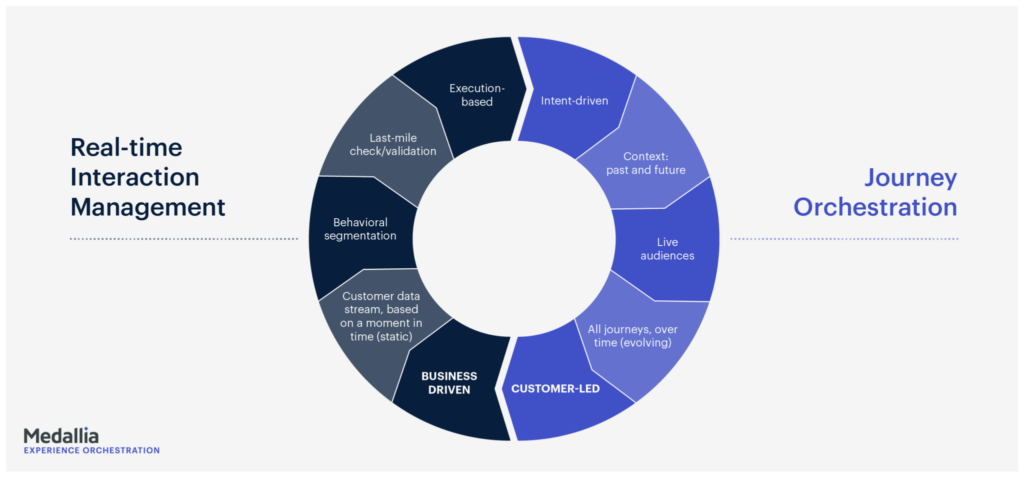What is Real-Time Interaction Management (RTIM) – and Why is Everyone Talking About It?
April 6, 2021
Customer Experience
The Forrester Real-Time Interaction Management Wave 2022 was recently released, and we’re delighted to have been named a Leader. Here we explain what RTIM means – and how it relates to Customer Journey Orchestration.
To understand why Real-time Interaction Management (RTIM) has enjoyed a meteoric rise in recent years (alongside Customer Journey Orchestration), it’s worth briefly setting the scene.
Generally speaking, campaigns represent a significant proportion of an organization’s communications with its customers. They are fundamental to a business, transmitting new offers or seeking to persuade an audience to purchase additional products and services. However, despite smarts in suppression and targeting, they are essentially one-way traffic; created with a business’s (not a customer’s) needs as the driving force.
Consumer expectations, particularly around the need to be understood as individuals, have risen. The catalyst creating an unprecedented race for customer-centric communications, products, and services is the fact that enterprise marketing technology has (finally) caught up to meet these expectations. This means global brand giants are able to reorganize around customers and deliver unique experiences at greater scale. Their associated digital experience (DX) design and development successes elevate benchmarks and customer expectations more generally, creating a challenge for other brands.
To be customer-focused, an organization must be customer-led. This usually means stepping away from a fixation on the numbers alone to a more service-oriented mentality, considering above all how customers engage with its products and people to drive growth. With the current surge in digital usage and direct relationships, more devices in play, and a wealth of data, it’s achievable for any organization (not just global giants) to deliver best-in-class experiences.
However, getting the experience right, making it instantaneous, and — most importantly — on the customers’ terms, can be tricky. This is when RTIM enters the arena.
What is Real-Time Interaction Management (RTIM)?
At its core, Real-Time Interaction Management is an in-the-moment decision engine. It aligns all utilized channels and powers hyper-personalized customer communications to create optimal and consistent experiences for every individual.
RTIM is an intelligent execution and delivery mechanism within Customer Experience (CX). You could describe it as “centralized decisioning:” RTIM forms a fundamental layer in a brand’s ambitions to deliver better in-the-moment experiences.
What one customer needs right now is often very different from what they will need in just a few minutes’ time – let alone hours.
At its core, it can be useful to think of RTIM as a “last-mile check.” This decisioning is in essence a final, up-to-the-minute verification enabling the right message – or no message at all – to be delivered to every single customer. There are myriad applications, for example:
- RTIM helps a brand avoid the promotion of its credit cards to someone who’s just failed a credit check.
- It probably isn’t appropriate to upsell to a customer five minutes after they’ve complained. RTIM ensures an audience is as suitable as possible.
- Equally, a business can prevent the expense of an outbound call when a more cost-effective email would be better placed for an individual, based on their (very) current value and behavior.
The addition of RTIM means an organization can know that it has done all it can to ensure that its customers have received the most relevant, empathetic, and compelling communications.
How does RTIM differ from Customer Journey Orchestration (and Do You Need Both?)
Customer Journey Orchestration and RTIM are highly specialized solutions enabling brands to provide individualized, lifetime customer experiences. (Note that these are more meaningful and quite different from conventional personalized experiences or communications.) Over time, lines between the two have blurred slightly, partly because they co-exist to provide customer-led experiences, but also since they have a highly symbiotic relationship. It’s a rapidly evolving space; some in the industry also argue that RTIM is a subcategory of Journey Orchestration. Nonetheless, there is clear distinction between the two, which is why Forrester invests in a separate Wave for each capability.
So, how can we delineate each from the another?
We’ve introduced RTIM: the “in the moment” decision engine, making cross-channel, up-to-date decisions based on recent context across touchpoints. While RTIM harnesses interactions to guide segmentation and targeting, it is still effectively “inside out,” making decisions with the needs of the organization coming first.
Customer Journey Orchestration (with its Customer Journey Analysis), on the other hand, listens to, understands, visualizes, and orchestrates journeys across all touchpoints and time (the end-to-end customer lifecycle), purely to improve the customer experience. Its journey-based approach is “outside-in” and individualized; CJO is concerned with the creation of customer value with every interaction, over the long-term.
By harnessing and responding to a customer’s intent (which evolves over time), Journey Orchestration then predicts future behavior and adjusts a journey in the moment for increased customer lifetime value. Because individuals can be on multiple journeys simultaneously — and profiles are perpetually evolving — audiences are now amorphous and fluid: “live” and complex. Customer Journey Orchestration represents the epitome of delivering a customer-led experience and inevitably, the customer engagement that follows provides positive impacts on operational efficiencies and business results.
RTIM and Customer Journey Orchestration Together
If RTIM is business-led, concerned with current execution and making the right decision for communicating in the moment, Customer Journey Orchestration is strategic, driven by customer intent, and conversing in the most valuable way over time. It follows then that Journey Orchestration needs RTIM in order to deliver when the time is right.
Armed with a true understanding of customer intent over time (thanks to Customer Journey context), RTIM takes on an incredible level of potency. Since meaningful experiences are only possible when driven by an understanding of the customer journey — and logically, communications must occur while insight is still relevant — each capability needs the other to complete a circle of customer-centricity. Together, customer Journey Orchestration and RTIM then provide short- and long-term consistency, demonstrable value and, since trust is won with every positive interaction, a deep level of engagement. Ultimately, both are needed if a brand is to have authentic, relevant (in-the-moment) and compelling conversations with its customers.
The Business Value of RTIM
The commercial impact of RTIM is significant, for obvious reasons: customers with better experiences pay more, stay longer – and serve as advocates.
Complex, instant decisioning is clearly advantageous for businesses with convoluted product and relationship structures such as retail or automotive, but it also provides demonstrable value to low-frequency purchase cycles, as seen in banks, utilities or insurers. After all, with fewer interactions (events) to draw on, it’s vital to make the most of each occasion and (literally) avoid sending out the wrong messages.










%20%E2%80%93%20and%20Why%20is%20Everyone%20Talking%20About%20it%3F%20%7C%20Experience%20Orchestration%20%E2%80%93%20Medallia&_biz_n=4&rnd=86664&cdn_o=a&_biz_z=1747251166123)
%20%E2%80%93%20and%20Why%20is%20Everyone%20Talking%20About%20it%3F%20%7C%20Experience%20Orchestration%20%E2%80%93%20Medallia&rnd=107499&cdn_o=a&_biz_z=1747251166124)